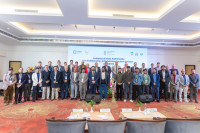National
Job schemes come into question as virus-induced unemployment hits rural youths hard
Several employment schemes have been rolled out to absorb the labour force at home, but they are failing to stop youths from migrating, and the trend has started with many leaving for India for work.
Chandan Kumar Mandal
Last week, when a group of Nepalis were crossing the Gaurifanta border in Kailali, Dinesh BK was among them. BK from Rukum was en route to India for work.
The 24-year-old from Rukum said he was preparing for a civil service job. But since the Public Service Commission examinations have been postponed due to the Covid-19 pandemic, he said he chose to go to Himachal Pradesh in India to work in apple orchards. Many Nepalis from the region have for years been working in the apple orchards in the Indian state.
BK said he lost his job in marketing in Surkhet, where he was also preparing for the Public Service Commission examinations.
“Since then I had been home doing nothing,” said BK. “When I heard that friends from my village were planning to go to Shimla to pick apples, I decided to join them.”
Everyone in BK’s group was below 30 years of age and have been studying in different cities of western Nepal.
Experts say the government plans to employ the youths at home would have worked better, had they been implemented well.
According to Ganesh Gurung, a labour and migration expert, if the various government schemes ensured opportunities at home, youths like BK would have stayed back.
“Those going back to India are among the poorest of the poor. First, workers from India returned home in the wake of the pandemic. Now, they are going back as there is no work here,” said Gurung, who is also a former member of the National Planning Commission. “Leaving behind their families and going back to India as the infections are increasing by the day is like going to war.”
While Covid-19 cases are rising in Nepal at an alarming rate, India has become one of the top countries to have the highest number of infections.
The number of coronavirus cases in India as of Saturday stands at 4,103,694, with more than 80,000 daily new cases reported over the last few days.
The Oli government’s flagship programme to create jobs at home–Prime Minister Employment Programme—seems to be not working, analysts say.
As part of the programme, the government aimed to create jobs for 200,000 people at the local level in this fiscal year.
But there are no jobs at the local level.
Such a desperate situation indicates that government programmes that promised jobs, even for a temporary period, have not reached targeted groups, according to Gurung.
“This is a systematic failure when Singh Durbar says they are sending a budget, but it’s not reaching the people,” Gurung told the Post. “That Nepalis are still migrating to India and also seeking labour permits for the Gulf only shows these schemes have not changed much for the groups that need jobs.”
Two years into its implementation, the Prime Minister Employment Programme, which promises a minimum 100 days of employment for unemployed registered citizens, have not shown promising results.
The Ministry of Labour, Employment and Social Security says that the programme generated employment opportunities for its target of 60,ooo people across the country in the fiscal year 2019-20.
But it has not met its target of a minimum providing 100 days of work a year for the target population.
Purna Chandra Bhattarai, a former labour secretary, said the programme, despite promising a minimum 100 days of employment, has not been able to provide jobs for 50 days .
The challenge has got even bigger with the return of Nepali workers from India and other labour destination countries.
As of now, more than 56,000 Nepalis have returned home by air, whereas an estimated 300,000-400,000 have returned to Sudurpaschim Province alone from India.
Karnali Province, from where BK is, and Sudurpaschim Province have the highest number of people who go to Indian cities in search of work.
Suman Ghimire, the national director of the Prime Minister Employment Programme, admits that Covid-19 has added to the challenge of job creation in the country.
“We are coordinating with stakeholders for internal job creation and discussing potential sectors,” said Ghimire. “But the programme cannot cover everyone. The programme priorities those who are from highly marginalised groups even among unemployed sections.”
According to Ghimire, funds are being sent first to the local level this year, and they have been asked to update the number of registered unemployed citizens.
After Covid-19 rattled the world’s economy, leading to massive job losses for Nepali workers at home and abroad, the Nepal government has pledged to create more than 700,000 jobs in the current fiscal year to provide employment to those affected by the pandemic.
Despite past failures and severe criticisms, the government has doubled its budget for the employment programme to Rs 11.6 billion this fiscal year from Rs 5.o1 billion in the fiscal year 2018-19.
Besides, the Labour Ministry has also received a soft loan of approximately Rs14 billion from the World Bank to implement the Youth Employment Transformation Initiative Project, a five-year project, under the employment programme.
This year the project has aimed to create 75,000 jobs for unemployed youths, primarily women.
“With the increase in the number of unemployed, local units have been asked to come up with programmes where more people could be employed,” said Ghimire. “They will come up with projects under the programme after the Labour Ministry sets criteria for them. We will also make sure that those working under the employment scheme are immediately paid.”
According to Bhattarai, the employment scheme itself is not a complete employment programme. But it can be useful for part-time job seekers and those migrant workers who are at home during vacation, he said.
“This nationwide programme can just be a supporting employment scheme, for example, for a farmer or someone who is free for a short duration,” Bhattarai told the Post. “We need to understand that this programme is only a kind of a social security initiative.”
But even the little social security it was supposed to provide has not been beneficial to unemployed citizens and they are forced to migrate even during the time of this pandemic.
“The Prime Minister Employment Programme should have at least provided short-term jobs and discouraged such seasonal migration,” said Gurung. “But there is no visible result, as people continue to migrate for basic needs.”
Rather than providing seasonal employment, the Prime Minister Employment Programme should focus on asset-building by developing skills, along with providing jobs, according to Bhattarai.
“The programme should be implemented in such a way that it promotes other economic activities at the local level and upgrades skills of those involved,” said Bhattarai. “Local units that implement the scheme should be strengthened. They should be communicated about the long-term benefits of developing skills rather than simply providing temporary jobs.”
Besides the presently unemployed, an estimated 500,000 labour force enters the labour market every year. With tens of thousands expected to return from abroad, the need to create jobs is huge.
The International Labour Organisation has estimated nearly 2million jobs have been affected in Nepal and an estimated 500,000 are expected to return home from abroad.
“The government plan to create more than 700,000 new jobs in itself is not easy,” said Bhattarai. “But nearly 3 million jobs are needed. We need to support and revive small and medium level industries for providing jobs at home.”




 9.12°C Kathmandu
9.12°C Kathmandu















